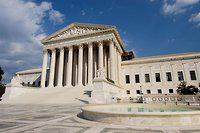

COURTS |
||
1. Decide arguments about the meaning of laws. |
2. How the laws are applied. |
3. Whether the laws break the rules of the Constitution. A judicial review is a courts authority to decide constitutionality. |
![]()

Sounds |
Questions |
Answers |
|
| 1. Supreme Court Justices are appointed for how long? |
|
||
| 2. How many members make up the Supreme Court Justices? |
|
||
| 3. Who appoints the Justices? |
|
||
| 4. How many judicial circuits and court of appeals are there? |
|
||
| 5. Who approves the Justices? |
|